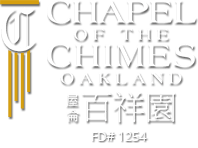Mausoleums and Columbariums
Since 1909, Chapel of the Chimes Oakland has been proudly serving the Bay Area as a columbarium and crematorium in Oakland. Our chapel is located in one of the most beautiful historic buildings in Oakland, which once served as a trolley car station for those visiting the adjacent Mountain View Cemetery. Today, our facility offers a place of dignity, elegance, and reflection to memorialize the life of your loved ones. Chapel of the Chimes delivers a variety of customized cremation and burial options, including funeral planning, signature services, and grief support for family and friends.
Julia Morgan and Aaron Green Design
Originally, Chapel of the Chimes consisted of a crematorium and columbarium, which housed the cinerary urns of those wishing to maintain a physical memorial onsite.
- As the original columbarium began to fill up, architect Julia Morgan was sought to create an addition; she began her work in 1926 and completed the new sections in 1928. Julia Morgan’s design included a new mausoleum, memorial chapel, offices, and meeting rooms for the Chapel of the Chimes. Her work features elegant Moorish and Gothic elements, such as ornate stone and tile work, fountains, statues, and gardens designed to mimic the Alhambra in Spain.
- In 1959, Chapel of the Chimes underwent a second expansion. This six-part expansion was designed by up-and-coming architect Aaron Green, a student of Frank Lloyd Wright. Green’s addition also transformed Chapel of the Chimes into the world’s first combination columbarium and mausoleum.
Chapel of the Chimes’ Cemetery Options
Columbaria and mausoleums offer an above-ground memorialization option for those who do not want interment in a traditional burial plot. Chapel of the Chimes can help your family find the right memorialization option, whether you prefer burial, entombment, or cremation in Oakland. You can reach us by phone at (510) 654-0123 to speak with a funeral director today.
- A columbarium is a place of public memorialization for cremated remains. The term originates from the Latin word “columba,” or “dove,” as the original design of these structures arose as a form of compartmentalized housing for doves. Today, columbaria contain indoor niches where one or more cinerary urns may be displayed as a public memorial for a loved one. These niches may be open, or covered with glass, stone, or a metal plaque that serves as an individual marker.
- Mausoleums offer above-ground indoor entombment for full-size caskets, as well as cremated remains. A mausoleum can provide a final resting place for individuals who don’t wish to be cremated or buried below ground. Mausoleums may be public buildings or private family structures; they typically contain several niches for caskets and cinerary urns.
